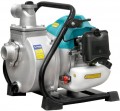Maximum head
The maximum head generated by the pump. This parameter is most often indicated in meters, by the height of the water column that the unit can create — in other words, by the height to which it can supply water. You can estimate the pressure created by the pump using a simple formula: every 10 m of head corresponds to a pressure of 1 bar.
It is worth choosing a pump according to this parameter, taking into account the height to which it should supply water, as well as adjusting for losses and the need for pressure in the water supply. To do this, it is necessary to determine the difference in height between the water level and the highest point of water intake, add another 10 to 30 m to this figure (depending on the pressure that needs to be obtained in the water supply), and multiply the result by 1.1 — this will be the minimum pressure required.
Engine specifications
The main characteristics of the internal combustion engine (see "Power") installed in the motor pump. This paragraph may include, in particular, the following points:
— Volume. The working volume of the cylinder (cylinders) of the engine. Larger displacement generally provides more power, but fuel consumption rises accordingly.
— Power. The power of gasoline and diesel engines is traditionally indicated in horsepower. The meaning of this parameter is the same as that of the nominal power (see above), indicated in watts. And some units can be easily converted into others: 1 hp. approximately equal to 735 watts. However, the designation in horsepower is more convenient for evaluating and comparing internal combustion engines.
— The number of cycles. In modern units with internal combustion engines, including motor pumps, 2-stroke or 4-stroke engines can be used. The first option is characterized by higher power and lower cost; its disadvantages are a high noise level and the need to refuel with a fuel-oil mixture, which is not very convenient. 4-stroke internal combustion engines are quite complex in design and expensive, but they are easier to operate, and they make less noise. Note that most 2-stroke engines are gasoline, diesel engines of this type are practically not found today.
— The number of cylinders. The presence of several cylinders contributes to the uniform rotation of the motor shaft. On the other hand, this feature signific...antly affects the size and weight, while uniformity for pumps is not critical. Therefore, the vast majority of engines in modern motor pumps are single-cylinder.
— Launch method. The engine can be started both manually and with an electric starter. For the first method, see above; manual start is more difficult (usually you need to pull a special cable with considerable effort, often several times), but it is more reliable, because. does not depend on the battery.
— Cooling type. In modern internal combustion engines, two types of cooling are used — liquid (water) and air. Specifically, in motor pumps, the vast majority of devices use the second option, because. air systems are much simpler and cheaper, and their efficiency, although lower than that of water systems, is still quite sufficient.
Fuel tank volume
The volume of the fuel tank in the water pump with an internal combustion engine (see "Power source"). Knowing this parameter and fuel consumption, it is possible to determine the maximum operating time of the unit on a single refill. Of course, the larger the tank, the longer the pump can work without refuelling, all other things being equal; on the other hand, a large capacity significantly affects the dimensions and weight of the device.

